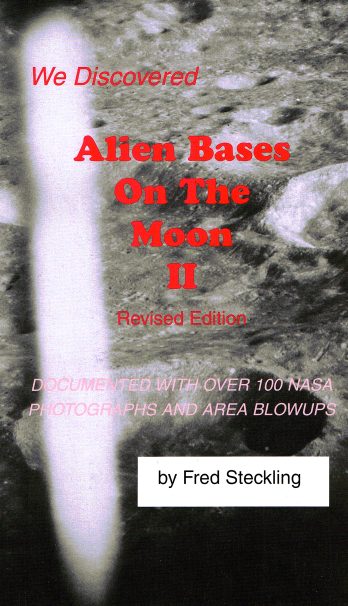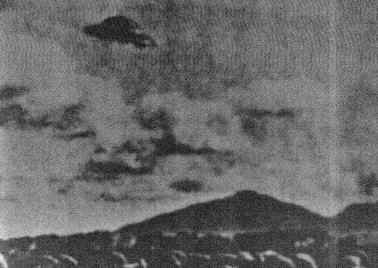
Contents:
Prologue 1
Introduction 12
Chapter 1 The Moon General Information 17
Chapter 2 The Apollo Lunar Mission of the United States 19
Chapter 3 Behind the Lunar Mysteries 23
Chapter 4 UFO Analysis 35
Chapter 5 Analysis of Advanced Civilization 51
Chapter 6 New Concepts Replace Old Theories 69
Chapter 7 True Colors on The Moon 81
Chapter 8 Gravity and Atmosphere on the Moon 87
Chapter 9 Water, Clouds, and Vegetation 97
Chapter 10 Photographic Analysis of Lunar Pictures 107
Chapter 11 Symbols, Signals and Markings on the Moon 131
Chapter 12 NASA Experts Reveal the Facts 143
Chapter 13 Probing Adamskiís Claims 175
Chapter 14 Changes Overdue 181
Chapter 15 Why Explore Space? 185
Chapter 16 Beyond the Moon 191
Epilogue 215
References 227


Adamski type Bellshaped Flying Saucer photograped by W. C. Hall in Australia 1954
Chapter 9 Water, Clouds, and Vegetation
The fact that water exists on the Moon has already been established by NASAís release, which reported
"spraying geysers of water." From the photographic evidence in this book, the reader will find that not only natural lakes
and ponds, but also artificial water reservoirs exist on the Moon (See plate #50).
From my studies I have found that much of the north pole area seems to be clouded over on occasion, and in certain
locations. Clouds are the product of condensed moisture which rises up to density altitude from the warm ground
below. For water clouds to exist, moisture on the ground must exist. Photographic analysis shows that the
condensations of clouds take place at very low altitudes. I estimate this altitude to be between two thousand and six
thousand feet above ground level.
It must be strange indeed, to stand in one of the low lying lunar valleys during the bright daylight, watching patches
of white clouds drift along in the black sky. It seems that the densest part of this atmosphere on the Moon is to be
found in the valleys and craters close to the so-called lunar sea level.
This law applies to Earth, so it should apply to the Moon. The lunar clouds formed at these very low altitudes, seem to hug
the mountain side, much like the monsoon clouds over tropical islands on Earth. While heavy cloud formations are quite
rare and appear to depend on the seasons, they do occur on occasion, mostly in the northern and southern
hemisphere on the Moon.
There are several natural lakes on the Moon, close to the north pole. These appear on photographs with a very
black surface. Photographs from outer space taken from above Earth in black and white or even color, show most
lakes to be black also. Since the sky on the Moon is almost black, naturally lakes on the Moon, and in fact all water
surfaces, will look black.
On the Moonís hidden side is found the crater Tsiolkowsky. Our astronauts have labeled this crater "The Lake".
The astronauts stated that its black surface looks exactly like a lake with water in it. Other vertical close-up
photos, taken during different missions, seem to show that the water in this lake is very shallow and very clear, for one
can see the bottom through the water. The only time when water does not look black from the air is when sunlight is
reflected from it, at which time it turns silvery white on the photographs. Plates #5 3 to #5 5 shows several artificial
reservoirs, with the sunlight reflecting from them.
Aerial photographs which I have taken over southern California show reservoirs very similar in appearance as those
photographed on the Moon. In California, these reservoirs with reinforced walls are used for irrigation purposes.
The presence of surface water on the Moon seems to depend very much upon the seasons as do the
southwest desert areas in the United States. However, oceans cannot be found on the Moon, and if they existed
long ago, they must have dried up. It is no secret that our solar system is an old one. Under these conditions it
seems that smaller planetary bodies dry up before the larger ones. In my efforts to search for vegetation on the
Moon, I did not detect any plowed fields or open growing areas.

Flying Saucer over Moondome photographed by Howard Menger 1956
As was mentioned earlier, hydroponic farming under those translucent domes would be much more
productive in any event. Much ground water must exist in the lunar mountains, especially on the hidden side.
Color photos clearly show the color green in the shady areas of brown colored hills and craters, very much in
appearance as the southwest desert areas.in the United States. While some color photos appear brown,
others definitely show a green color. One can only speculate that this may be due to seasonal changes.

We must understand that even on the Moon a natural balance would take place very much like on Earth. If there
are water clouds and vegetation on the Moon, it seems reasonable to assume that also some form of animal life
exists there. To maintain a natural balance, some form of animal life would be necessary. One wonders how
life forms would appear under different pressures. Here, some people, authors and movie makers alike,
permit their imaginations free reign. l feel we can explain that life forms do not change very much in their
geometrical appearances, living under higher or lower pressures, as we are familiar with on Earth.
In our oceans, the fish that live close to the surface share a very common physical appearance with those fish
living at great depths. Even man can safely dive several thousand feet below the sea by using air mixtures of
oxygen and hydrogen. One could repeat that man is not only the most adaptable machine in the universe,
but his place is the universe. Man is never confined, and to travel anywhere in the Cosmos all that is necessary
is the technical knowiedge.
In a recent scientific article the scientists argued that surface water could not exist on low gravity worlds, such as
the Moon. They theorized that the water molecules would quickly escape into space because of the low gravity and
atmospheric pressures. However, this assumption seems contradictory. Many dried out riverbeds on the Moon
suggest there existed heavy run-off of water. If the surface water would have quickly disappeared into space, as
suggested, then these riverbeds could not be there. It requires eons of time for water to carve these riverbeds.
page 97-105


Glenn Steckling Co-Author
I give the book










of ten candles, because this is the best book about Moon and those who live there.
back to linkpage
suggestion
read and sign my guestbook

















